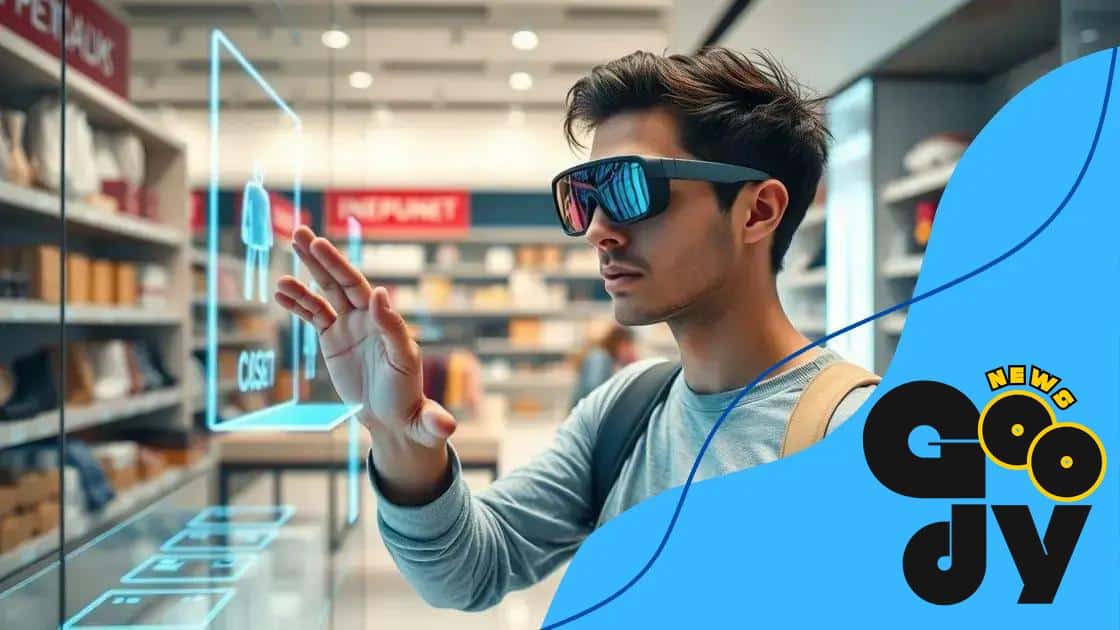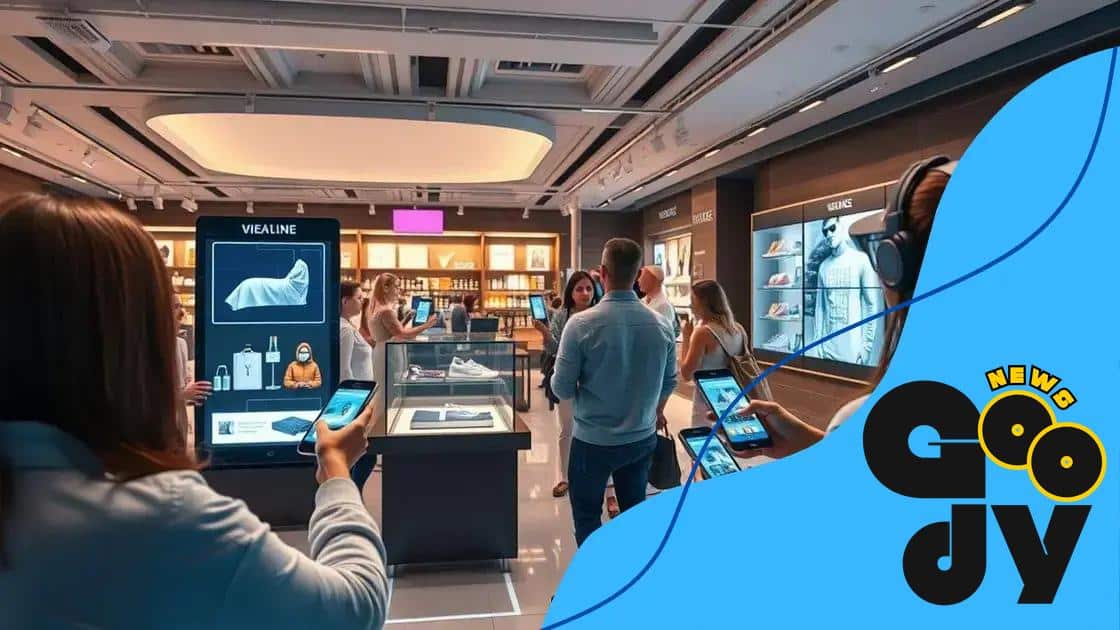Augmented reality for immersive retail experiences

Augmented reality enhances retail experiences by allowing customers to visualize products in their own environment, interact with virtual items, and enjoy personalized shopping journeys, ultimately improving engagement and purchase decisions.
Augmented reality for immersive retail experiences offers a new way for customers to engage with products. Have you ever thought about how this technology could transform your shopping trips? Let’s explore the fascinating possibilities.
Understanding augmented reality in retail
Understanding augmented reality in retail is crucial for businesses looking to innovate. This technology merges the physical world with digital information, creating unique shopping experiences.
Imagine walking into a store and using your smartphone to see what a piece of furniture would look like in your living room. Augmented reality makes this possible by layering virtual elements over real-world views.
Key Features of Augmented Reality in Retail
Retailers using AR can engage customers in various ways:
- Virtual try-ons for clothing and accessories.
- Interactive displays that show product features.
- Navigation aids within stores to locate products.
These features enhance the shopping experience, making it entertaining and informative. As a result, customers can make better purchasing decisions.
Benefits for Retailers
Utilizing augmented reality provides retailers several advantages:
- Increased customer engagement and interest.
- Boosted sales through enhanced experiences.
- Opportunities for brand differentiation.
Retailers can leverage these benefits to create memorable shopping experiences. By understanding how AR works, businesses can implement strategies effectively.
In addition to improving customer interaction, augmented reality helps retailers gather valuable data on customer preferences. This information can drive future marketing strategies and product offerings. With the right tools, businesses can continue to innovate.
Benefits of augmented reality for customers
The benefits of augmented reality for customers are transforming the way people shop. With this innovative technology, shoppers can interact with products in new and exciting ways. For instance, they can visualize how furniture fits in their homes or see how clothing would look on them without trying it on.
Imagine a customer using their smartphone to view a 3D model of a new couch right in their living room. Augmented reality bridges the gap between online shopping and the real-world experience. This technology enhances decision-making and reduces the uncertainty often associated with purchases.
Key Advantages for Customers
Here are some significant perks that AR offers to shoppers:
- Interactive engagement with products and better understanding.
- Time savings by visualizing items quickly.
- Increased confidence in purchase decisions.
Such advantages make shopping more enjoyable and less stressful. Shoppers appreciate being able to see how products will align with their needs.
Personalized Shopping Experience
Another major benefit of augmented reality is personalization. Retailers can tailor recommendations based on individual preferences. When customers use AR, they often receive relevant suggestions that enhance their shopping journey.
This level of personalization makes customers feel valued, fostering loyalty. They are more likely to return to stores that meet their specific needs. As technology evolves, the experiences will become even more sophisticated, keeping customers engaged and interested.
Overall, the implementation of augmented reality in retail truly benefits customers. It not only improves their shopping experience but also allows them to make informed choices. As this technology grows, it will continue to play a crucial role in transforming retail.
How to implement augmented reality in stores

Implementing augmented reality in stores can seem challenging, but it offers exciting opportunities for retail transformation. The integration of AR technology allows retailers to provide customers with engaging shopping experiences that enhance their decision-making process.
To successfully implement augmented reality, retailers must follow a few key steps. First, identifying the right technology is essential. Retailers can choose from various software and hardware solutions tailored to their specific needs. Options range from smartphone applications to specialized hardware like smart mirrors.
Steps to Implement AR in Stores
Consider these steps when planning your AR strategy:
- Define your goals for using augmented reality in-store.
- Choose the appropriate technology that suits your brand and customer preferences.
- Design engaging AR experiences that offer value to customers.
- Test and optimize the implementation based on customer feedback.
These steps create a roadmap for integrating augmented reality effectively. Once you have defined your goals, creating an engaging experience is next. This means using AR to enhance product information, allowing customers to visualize products in their own spaces or even view personalized recommendations.
It’s also important to consider the training of store employees. Staff should be knowledgeable about the AR system and be able to assist customers in using it effectively. By creating a supportive environment, businesses can encourage more customers to try the technology.
Analyzing Success and Customer Feedback
After rolling out the augmented reality experience, it’s crucial to analyze its performance. Gathering customer feedback can help retailers understand what works and what needs improvement. Adjusting the AR experiences to meet customer desires can significantly increase satisfaction and sales.
Overall, implementing augmented reality in stores involves technology selection, experience design, and ongoing analysis. By carefully strategizing each step, retailers can create rich customer interactions that elevate the shopping journey.
Case studies of successful AR retail applications
Examining case studies of successful augmented reality retail applications reveals how different brands leverage this technology effectively. These examples highlight the potential of AR to transform customer experiences and boost sales.
Several major retailers have adopted AR, creating engaging and interactive shopping journeys. For instance, IKEA’s app allows customers to visualize furniture in their homes. By using the app, users can see how products fit and look in their space before making a purchase.
Examples of Successful AR Implementations
Let’s explore a few standout examples:
- Sephora: Their virtual try-on feature lets customers test makeup products through their smartphones, making shopping more personal and fun.
- Warby Parker: The brand offers an app that enables customers to virtually try on glasses, helping them decide on styles that suit their face shape.
- Adidas: They created an AR experience that allows shoppers to see how sneakers would look on their feet through the app, enhancing the online shopping experience.
These brands successfully demonstrate how augmented reality can improve customer engagement and satisfaction. As customers enjoy these immersive experiences, they are likely to share their experiences, which further boosts brand visibility.
Another interesting case is the furniture retailer Lowes. They implemented an AR tool that assists customers in visualizing home improvement projects. Users can scan their surroundings and see virtual overlays for tools and materials, simplifying the decision-making process.
These case studies underline the power of augmented reality in retail. As technology evolves, more brands are likely to adopt these advancements, creating richer customer interactions and promoting brand loyalty.
Future trends in augmented reality for retail
Future trends in augmented reality for retail promise to revolutionize the shopping experience even further. As technology advances, retailers will adopt more sophisticated AR solutions to enhance customer engagement.
One of the key trends is the integration of AR with artificial intelligence. This combination will allow for more personalized shopping experiences. For instance, smart systems can analyze customer preferences and suggest products tailored to individual tastes.
Emerging Technologies
Retailers are also looking at virtual reality (VR) as a complement to AR. While AR overlays digital information onto the physical world, VR creates a completely immersive environment. Together, these technologies will create exciting new shopping experiences.
- In-store experiences where customers can use both AR and VR.
- More interactive customer service options through AR interfaces.
- Enhanced data analytics to track customer behavior in real-time.
This means customers can interact with products in ways never before imagined. Imagine shopping in a virtual store from the comfort of your home and trying on clothes or accessories using AR! This future is not far away, as many brands are already piloting these technologies.
Increased Accessibility
As AR technology becomes more accessible, more retailers will integrate it into their existing platforms. Smart device adoption continues to rise, allowing customers to easily connect to AR applications via their smartphones and tablets.
Additionally, brands will focus on creating seamless experiences across multiple channels. Customers will expect to find the same engaging AR functionalities on mobile apps, websites, and in-store displays. This level of consistency will help in building stronger customer relationships.
Moreover, sustainable practices will influence future AR trends. Retailers will use AR to minimize waste during the product testing phase, allowing consumers to visualize products without physical samples. This forward-thinking approach aligns with growing consumer demand for sustainability.
FAQ – Frequently Asked Questions about Augmented Reality in Retail
What is augmented reality in retail?
Augmented reality (AR) in retail is a technology that overlays digital information and images onto the real world, enhancing the shopping experience.
How can I benefit from using AR in my store?
By using AR, you can improve customer engagement, allow virtual try-ons, and help customers visualize products in their own space, leading to more informed purchasing decisions.
What are some examples of successful AR applications in retail?
Examples include IKEA’s app for visualizing furniture in homes, Sephora’s virtual makeup try-on, and Warby Parker’s virtual glasses fitting.
What trends should I expect in the future of AR in retail?
Expect trends like AI integration for personalization, increased accessibility through smartphones, and sustainability efforts using AR to reduce waste.





